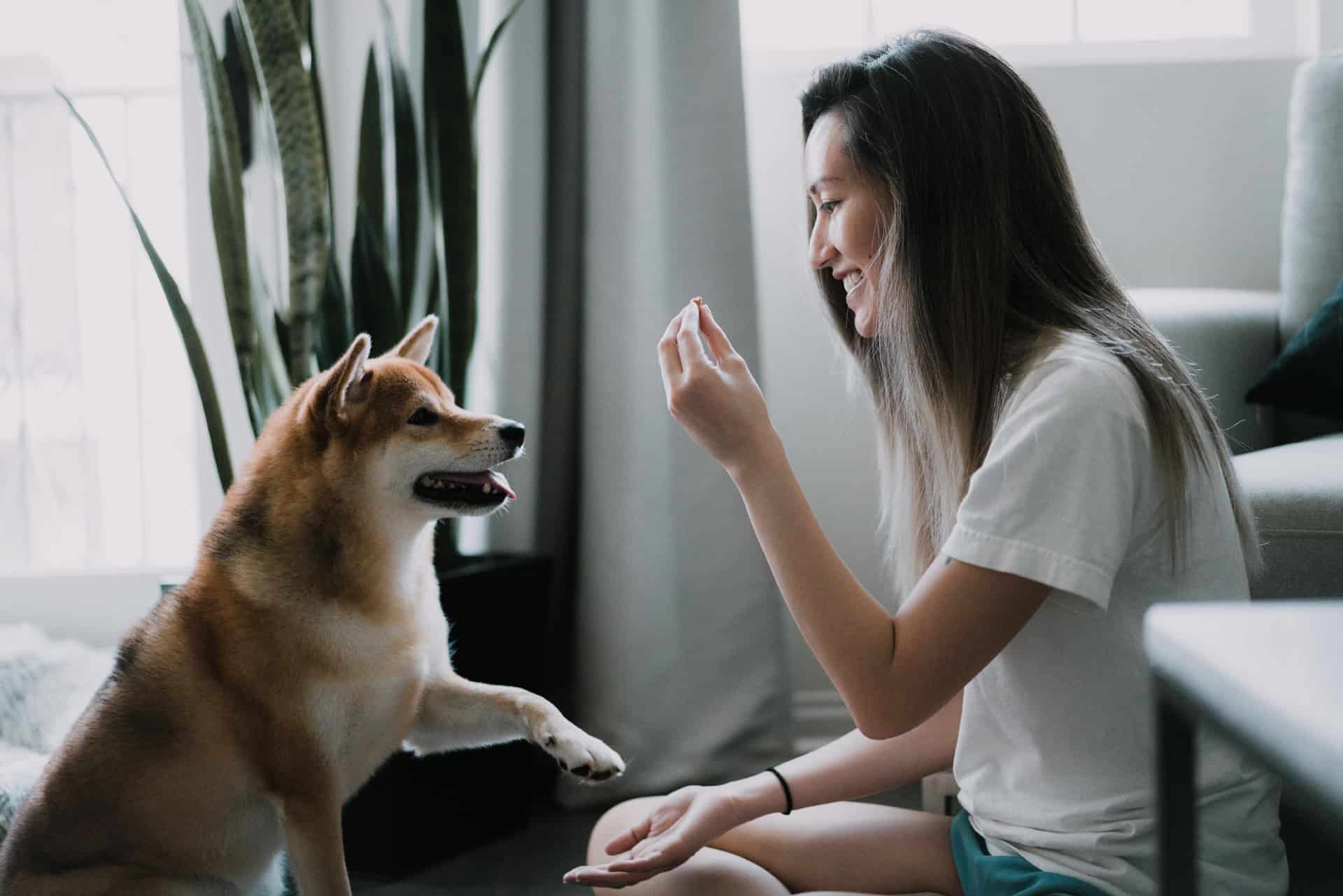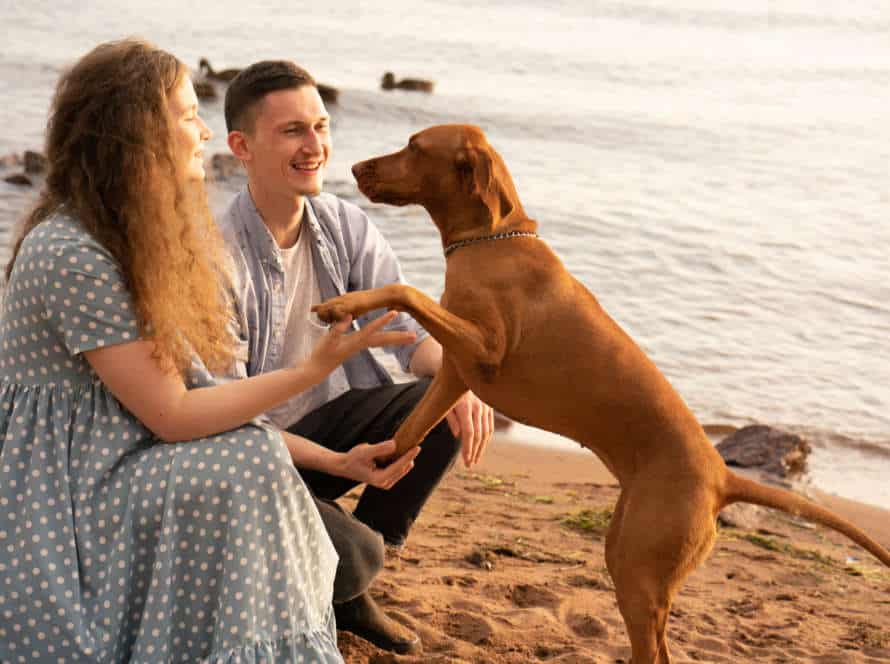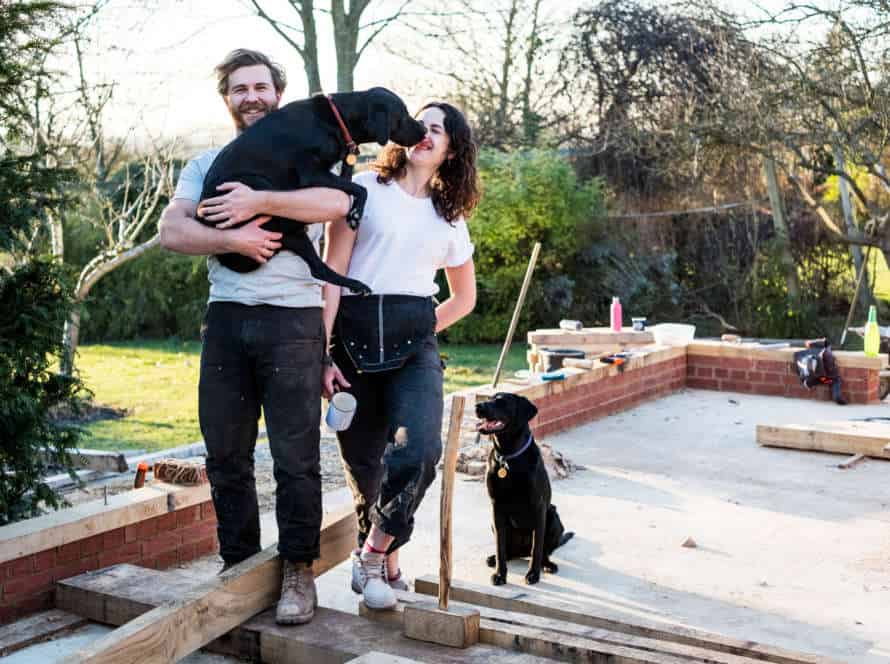Positive Reinforcement: A Dog Trainer’s Secret Weapon
Positive reinforcement is a great tool when training your pup. It focuses on rewarding good behavior, and ignoring bad behavior which encourages your pup to act properly.
To use this method, do the following:
- Identify the behaviors you want your dog to have, such as sitting, staying, or not jumping on people.
- Choose a treat or toy your pup loves, and use it to reward them for performing positive behavior.
- Ignore negative behaviors and avoid punishing them.
- Be consistent with rewards to reinforce positive behavior and avoid confusion.
- Positive reinforcement works best with clear communication, patience and repetition.
Communication with your pup is key for successful training.
Pro tip: Start training with simple commands and move to complex behaviors as your pup progresses.
Understanding Positive Reinforcement Dog Training
Positive reinforcement dog training is a great way to teach a pooch obedience and behavior. It uses rewards and praise to encourage the pup to do what you want. Let’s look at the basics of positive reinforcement dog training. It is effective in forming a bond between you and your dog. It motivates them to complete desired behaviors. Understanding how positive reinforcement works is key for successful dog owners and trainers.
Definition of positive reinforcement training
Positive reinforcement training is a great way to reward your pup for good behavior and encourage them to do it again! It involves using treats, pats, or playtime to reward your dog for desirable behaviors. Instead of punishing bad behaviors, positive reinforcement training focuses on rewarding the good.
This type of training helps build a strong bond between dog and owner. Plus, it helps dogs to learn commands faster. Positive reinforcement should be used alongside other training methods for best results. Studies show that it’s effective for improving obedience and behavior.
For best results, start small when training your pup. Consistency is key, as well as lots of praise and affection!
Positive reinforcement as a scientific approach to dog training
Positive reinforcement is a scientific and effective way to train your dog. It means rewarding good behavior instead of punishing bad behavior. This method is humane, builds trust and has long-term results.
When your pet does something you like, give them treats, praise, or play. For example, if they sit on command or come when called. Over time, your dog will associate good behavior with positive consequences.
For successful positive reinforcement training, here are some tips:
- Rewards must be given immediately after the desired behavior.
- Use treats with high value for more difficult behaviors.
- Keep training short and frequent to keep the dog interested.
Positive reinforcement is the dog trainer’s secret weapon. It can help any pet owner create a happier and more obedient pup.
How positive reinforcement differs from traditional training
Positive reinforcement differs from traditional training. It motivates and rewards the desired behavior. Traditional training uses punishment or correction to stop an unwanted behavior. But, positive reinforcement focuses on encouraging and rewarding the wanted behavior.
Positive reinforcement dog training rewards a dog’s good behavior with treats, praise, and play. This increases the chance of the behavior happening again. It also creates a strong bond between you and your dog. It establishes trust and respect.
Traditional training methods, such as choke collars or shock collars, can lead to fear and aggression in dogs. This makes training less effective and creates a negative association with training.
Positive reinforcement training is a better approach. It’s humane, effective, and promotes better behavior, a stronger bond, and a happy, healthy dog.
Positive Reinforcement Techniques
Positive reinforcement is essential for teaching your pup new behaviors. Rewards are a great way to strengthen a certain behavior, making it more probable for the dog to depict it again. Treats, verbal praise and petting have been acknowledged as successful positive reinforcement techniques. Here, we’ll take a peek at how to use these practices, and how they can assist you in training your furry friend.
Clicker training
Clicker training is a positive reinforcement method approved by experts in the dog training world. It requires a clicker, a small handheld device that makes a clicking sound, to let your dog know they’ve done something correct and will be rewarded. Clicker training is used to form new behaviors, fix bad behavior, and reduce worry and stress in dogs.
Positive reinforcement, the central concept of clicker training, is about encouraging and rewarding your dog for behaving well instead of punishing them for bad behavior. By emphasizing on giving rewards for proactive and wanted behavior, clicker training strengthens the bond between you and your four-legged friend while building their trust and assurance.
In addition, it is a humane and natural way to train dogs as it requires no physical punishment or abuse. With a little perseverance and practice, anyone can learn clicker training and create a well-mannered, content, and healthy pet.
Treat training
Treat training is a great way to train dogs! Rewards of treats are used to positively reinforce desired behaviors. When the pup does something right, they get a treat – this links the behavior with the reward, and the dog will repeat it in the future.
Benefits of Treat Training:
- Positive reinforcement is more successful than negative, which can damage trust and cause problems.
- Strengthens the bond between pup and trainer as they associate the trainer with good things.
- Allows for diverse training opportunities, like teaching ‘sit’, ‘stay’, and ‘come when called’.
In summary, treat training is an effective and positive reinforcement technique that strengthens the bond between pup and trainer and encourages desired behaviors. Remember to choose the right treat type and size for your pup’s diet and health!
Praise and positive attention
Positive reinforcement is key when it comes to training your pup. Praising and providing attention is an easy way to do this. Here’s how:
- As soon as your furry friend does the desired behavior, be sure to praise them.
- Use an upbeat and enthusiastic tone when you compliment them.
- When your pup behaves well, show your love through treats, petting, and playtime.
- Be consistent with your praise and rewards so they can repeat the behavior.
Remember, your pup wants your attention and affection more than anything else. Positive reinforcement is the go-to for successful dog trainers.
Pro tip: Patience and consistency are key. Dogs need routine and repetition to thrive.
The Benefits of Positive Reinforcement Dog Training
Positive reinforcement dog training is effective and popular. It focuses on rewarding desirable behaviors from dogs and is based on science. This technique is great for nervous or scared dogs since it does not use aversive techniques like physical punishment.
Let’s look at the benefits of this approach. We’ll discuss it so that pet owners and trainers can understand the advantages.
Increased obedience and compliance
Positive reinforcement dog training is an effective way to boost obedience and obedience in your pup – while increasing your connection with them. Not like traditional training techniques which use punishment and dominance, positive reinforcement training focuses on rewards and compliments to teach pets desirable behaviors. Here are the benefits:
- It motivates good behavior – by giving treats, compliments, or play for good behavior, dogs learn that positive things bring positive outcomes.
- It strengthens the bond with your pet – positive reinforcement training includes spending time with your pup, encouraging their good behavior, and creating trust and understanding.
- Suitable for all ages and breeds – positive reinforcement training can be adapted to fit any dog, regardless of age, breed, or personality.
Using positive reinforcement as a tool for dog training can make the connection between humans and their furry friends more enjoyable and interactive.
Reduced stress and anxiety for the dog
Positive reinforcement dog training is a great way to reduce stress and anxiety in your pup. Plus, it’s fun! Here are the benefits:
- Trust: Use positive reinforcement to build trust between you and your pup!
- Learning: When your pup does something right, they’ll know it. This encourages them to do it again.
- Anxiety: With positive reinforcement, you create a low-stress environment for your pup. This makes them feel more relaxed.
- Socialization: This type of training provides a safe place for your pup to learn. They’ll feel more confident around new people and animals.
Pro Tip: Use consistent positive reinforcement for a happy and healthy relationship with your pup!
Enhanced bond between owner and dog
Positive reinforcement dog training is an awesome way to strengthen the bond between pet owners and their furry friends. Instead of punishing bad behavior, this style of training focuses on rewarding good behavior. Here are some of its benefits:
- Builds trust and respect between the owner and pup.
- Strengthens the relationship and encourages communication.
- Provides a fun learning environment that encourages obedience.
- Reduces behavior problems and stress for both.
By using positive reinforcement tools such as treats, compliments, and playtime, dog owners can raise great dogs. Positive reinforcement is an amazing tool for creating a loving relationship between owners and their dogs.
Common Mistakes to Avoid in Positive Reinforcement Dog Training
Positive reinforcement is an awesome dog training method. However, it’s not guaranteed to work in every case. To make sure it works, avoid these common mistakes:
- Not using enough treats or rewards.
- Not starting with easy tasks.
- Not giving rewards fast enough.
- Not being consistent.
- Rewarding bad behaviour.
Timing of reinforcement
Timing of reinforcement: key for positive reinforcement dog training. Re-enforcing good behaviour with rewards, like treats or praise, helps your dog repeat those behaviours in the future.
Common mistakes to avoid:
- Delayed reinforcement – if you wait too long, your dog won’t understand which behaviour you are rewarding.
- Inconsistent reinforcement – rewards only some of the time can make your dog frustrated and confused.
- Incorrect reinforcement – if you reward for a behaviour you don’t want, you’re reinforcing something you don’t want.
Key is to reinforce good behaviour immediately and use clear cues to communicate. This helps them know which behaviours are desirable.
Pro tip: Positive reinforcement is only part of it. Exercise, structure and socialization is also important to help your pet be happy and well-rounded.
Inconsistency in training
Inconsistency is a mistake to avoid in positive reinforcement dog training. Some reasons? Clear communication is hard if there’s inconsistency. Your pup can be confused. Also, friction between you and your pup can happen. So, be patient, clear, and consistent. Pro tip: Have shorter, focused training sessions to avoid inconsistencies and keep your pup interested.
Overdependence on treats
Giving treats too often can be an error when it comes to training a dog. Treats are good to motivate and reward a pup, however, over-dependence can cause issues such as obesity or a dog only listening if food is present. Here are some tips to stop overdependence on treats:
- Praise and love your pup too, not just treats.
- Change the treat reward regularly, to keep pup interested.
- As pup becomes more skilled and reliable, gradually reduce treat rewards.
- Positive reinforcement with playtime or a toy is a great alternative.
Positive reinforcement is a secret weapon for humane, successful training.
Success Stories: Real-world Examples of Positive Reinforcement Dog Training
Positive reinforcement is a great way to train dogs! Many have had success with it. Let’s explore real-world examples of this approach. We can see how it has been used to make dogs good family members. We’ll discuss some amazing stories of positive reinforcement training, and the outcomes of these trainers.
Practical applications of positive reinforcement training
Positive reinforcement training has many uses and has been successful in dog training, as seen in real-world stories.
Examples of its applications are:
- Teaching commands like sit, stay, and come with treats and praise as rewards.
- Potty training using rewards to help dogs eliminate in a designated area.
- Helping dogs overcome fears and anxieties such as noise phobias, separation anxiety or fear of strangers.
- Modifying behaviors like excessive barking or jumping on guests.
Positive reinforcement training not only makes dogs well-behaved but also strengthens your bond with them.
Tips for implementing positive reinforcement techniques effectively
Positive reinforcement is a powerful tool for dog training. Here are some tips for using it effectively:
- Be consistent. Set clear expectations and reward your pup every time they meet them.
- Timing is key. Reward good behaviors as soon as they happen. This links the behavior to the reward.
- Gradually increase difficulty. Start with basics and make the tasks more difficult slowly.
- Variety of rewards. Praise, treats, and playtime make training fun and motivate learning.
Positive reinforcement helps reinforce wanted behaviours. And it communicates expectations better. So, use it today and unlock your dog’s potential!
Discussion of outcomes and results
Positive reinforcement is a powerful tool for dog trainers. Real-world examples show it works! Here are some success stories:
- “Special”, a golden retriever service dog, was trained with positive reinforcement to help a child with autism. This pup was an amazing companion and support system.
- “Max” was a fearful rescue dog. Positive reinforcement helped him get over loud noises and strangers, giving him a better life.
- “Charlie” was trained with positive reinforcement and became so well-behaved he could be taken off-leash and run around in a fenced-in area.
These stories show how positive reinforcement training can lead to happier, healthier dogs.
Frequently Asked Questions
Q: What is positive reinforcement?
A: Positive reinforcement is a training technique that involves rewarding your dog for good behavior. It’s a way of reinforcing desirable actions so that your dog is more likely to repeat them in the future.
Q: What kind of rewards should I use for positive reinforcement?
A: The reward you choose should be something your dog really enjoys, such as treats, toys or affection. Make sure it’s something your dog only receives when they perform the desired behavior.
Q: Can positive reinforcement be used to train any dog?
A: Yes, positive reinforcement can be used to train any dog, regardless of their breed, age or temperament. It’s a gentle and effective way to teach your dog new behaviors and reinforce good ones.
Q: Is positive reinforcement the same as bribing my dog?
A: No, positive reinforcement is not the same as bribing your dog. Bribing involves offering a reward before your dog performs the desired behavior. Positive reinforcement involves rewarding your dog after they perform the desired behavior.
Q: How can I incorporate positive reinforcement into my dog’s training?
A: To incorporate positive reinforcement into your dog’s training, start by identifying the behaviors you want to reinforce. Then, choose a suitable reward and use it consistently when your dog performs that behavior. Be patient and consistent, and your dog will soon learn what is expected of them.
Q: How long does it take to see results using positive reinforcement?
A: The amount of time it takes to see results using positive reinforcement can vary depending on the dog and the behavior being trained. However, with patience and consistency, most dogs will start showing improvement within a few weeks.







